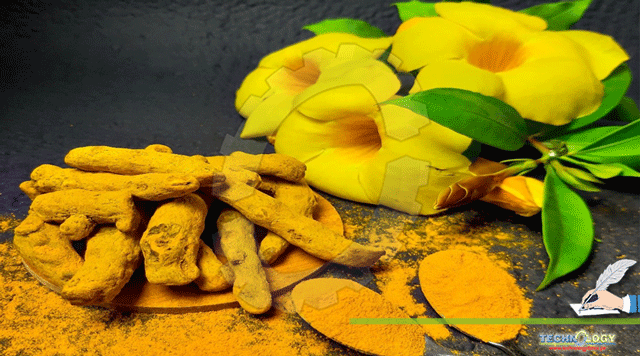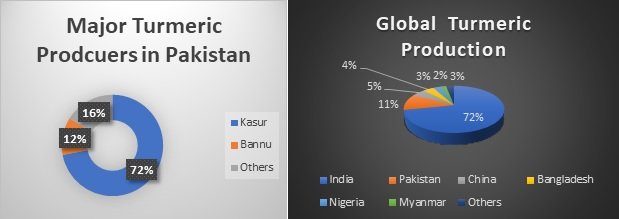Turmeric (Curcuma Longa), a ginger family flowering plant, contains curcumin, a golden chemical vastly used in edibles and cosmetics. It is used to flavor curry powders, butter, mustards, and cheeses. But root is often utilized in therapy. Cancer, smallpox, chickenpox, wound healing, urinary tract infections, and liver disorders treated with it.

By: Muaz Ameen, Maria Naqvi, Safura Bibi, Athar Mahmood, Muhammad Anjum Zia
Turmeric also referred to as Indian saffron, rhizomes are used dried and fresh. It has farmed commercially throughout Southeast Asia. Almost 4,000 years old crop in India. It had reached China, East Africa, West Africa, and Jamaica by 700 AD. Pakistan Yields 11% of the world’s turmeric production, majorly in Kasur and Banu. The suitable time for cultivation is April-May, per acre 2500 kg finger rhizomes used. Each acre yields 20-25 tonnes of turmeric. The appropriate time for cultivation is April-May, per acre 2500 kg finger rhizomes used. Each acre produces 20-25 tonnes of turmeric. Pakistan is a small producer of turmeric, exports it to its neighborhood. 1340 tonnes of turmeric worth Rs22.3 million were shipped in 2001-04. The state had to buy turmeric due to rising demand.

The rhizome used in cooking and medicine. For this reason, used in Ayurveda, an ancient Indian medical practice. It also sold as a dietary supplement for arthritis, gastrointestinal issues, respiratory infections, allergies, hepatitis, and depression. Curcuminoids make up about 5% of turmeric’s effects: a yellow-oil resin coloring element. Curcuminoid is mostly curcumin. It is also an ordinary skin paste. It is fugitive as well, and will quickly fade out no matter what you do to it.
Turmeric Usage & Efficiency
Turmeric is used topically for arthritis, irritable bowel syndrome (IBS), high cholesterol, lichen planus (a skin condition caused by radiation treatment), Crohn’s disease, and ulcerative colitis.
In addition to these uses, it is used to treat cancer and fibromyalgia. Further applications are anterior uveitis (middle layer of the eye swelling), diabetes, water retention, worms, SLE, TB, urinary bladder inflammation, and kidney issues. Inflammatory skin disorders and sores (acne), discomfort within the mouth, infected wounds (gingivitis), gum disease are treated with it and also used as an enema for IBD.
It’s essential oil is utilized in fragrances, and its resin is used to flavor and color dishes.
Taken orally three times daily for eight weeks improves itching in persons with chronic renal disease. People with persistent itching from mustard gas may benefit from using a particular combination medication (C3 Complex, Sami Labs LTD) combining curcumin plus black pepper or long pepper daily for four weeks.
In obese patients with high cholesterol, consuming turmeric extracts two times daily for 12 weeks decreases total cholesterol, LDL cholesterol, and triglycerides. Extracts, alone or combined with other herbal constituents, have been shown to relieve stress and help osteoarthritis patients.
Dosage For curcumin
Pediatric and adult supplements optimized to 95% curcumin.
Dosing in Adults include high cholesterol patients, 1.4 g turmeric extract split twice continuously for three months. For itching purposes, 1500 mg turmeric 3 times daily for eight weeks. It also included turmeric extracts (C3 Complex, Sami Labs LTD) and peppercorns or chili peppers. For osteoarthritis, take 500 mg of turmeric 4 times daily for four to six weeks. 500 mg ingested 4 times daily for Indigestion. In Colorectal Cancer, 440-2200 mg curcumin extract (curcumin 36-180 mg) once day for four months.
children with high cholesterol, give 1.4 g turmeric extract in two separate doses continuously for three months to children over fifteen. Turmeric has no dose restrictions.
Side effects of Turmeric
Turmeric is Probably Safe when used orally for up to 8 months. Short-term usage of as an enema or rinse may be safe. It has few negative effects, yet some individuals report gastric distress, vomiting, fatigue, or diarrhea. In one case, a person taking over 1500 mg of it two times a day had a hazardous irregular cardiac rhythm. However, it is unknown whether turmeric caused this negative effect. Avoid taking big dosages until something is discovered.
Additional Preventions and Cautions
Turmeric is Probably Safe when taken orally in levels found in food. However, using as a supplement during maternity is probably hazardous. It may trigger a menstrual period or excite the uterus, compromising fertility. Pregnant women should not use medical turmeric. The safety of medicinal turmeric while breastfeeding is unknown. It is best avoided.
It contains Curcumin that could lower blood sugar in diabetic patients. Use with care because it can make blood glucose levels very low.
It might induce gastrointestinal distress in certain individuals. It could make gastrointestinal disorders (GERD) worse. Don’t use turmeric if it increases GERD symptoms.
It might worsen gallbladder issues, so it should not use if you have gallstones.
It may reduce blood coagulation. Those with bleeding problems may have more bruising and blood loss. It may help blood clot, induce postoperative haemorrhage. Avoid taking two weeks before surgeries.
It includes curcumin, which is similar to estrogen and may worsen hormonal issues. It may inhibit the effects of estrogen in specific hormone-sensitive tumor cells. So, may help hormone-sensitive illnesses. When taken orally, it may reduce testosterone production and sperm mobility and induce infertility. Must be taken with caution by pregnant mothers. High doses may inhibit iron absorption. Use with care if you have an iron deficit.
Turmeric’s health benefits are typically obtained via long-term dietary use, even at small concentrations. To utilize effectively in treating human ailments, one must first understand its effective dosage, safety, and mechanism of action. More research is needed before turmeric may be used to satisfy human requirements and improve human wellbeing. Tocopherol is a powerful antioxidant that reduces the risk of heart attack and stroke. It contains several components with significant pharmacological activity, including volatile oil, curcuminoids, and curcumin.
Authors: Muaz Ameen, Maria Naqvi, Safura Bibi, Athar Mahmood, Muhammad Anjum Zia. University of Agriculture Faisalabad.